Cocoa butter is a fatty substance that is derived from the cacao bean and is often used in the cosmetics and skincare industry. It has a number of beneficial properties for the skin, making it a popular ingredient in many products. Whether you're looking to moisturise your skin, protect it from the sun, or reduce the appearance of fine lines and wrinkles, cocoa butter can be a great option.
Benefits of cocoa butter for lips
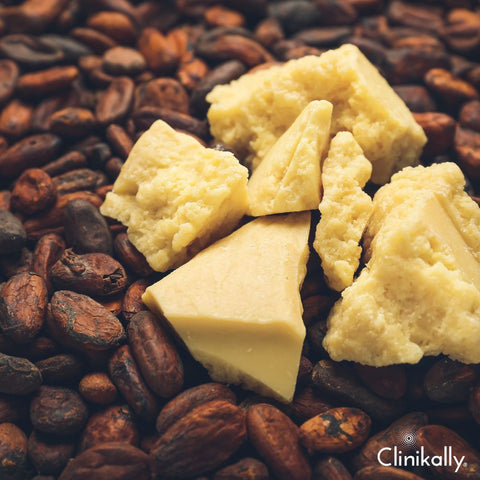
Cocoa butter is well-known for its moisturising characteristics, making it an attractive option for lip care. Here are a few advantages of using cocoa butter for lips:
-
Moisturizes and softens lips: Cocoa butter is rich in fatty acids and antioxidants, making it an excellent moisturiser for dry, chapped lips.
-
Protects lips from sun damage: Cocoa butter has a natural SPF of around 10, which can help to protect the lips from sunburn and other forms of sun damage.
How to apply cocoa butter on lips
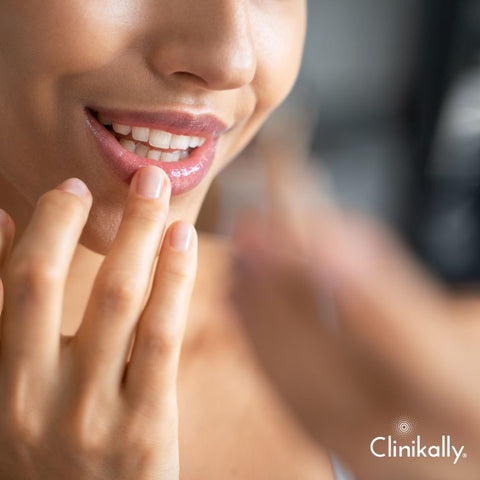
Applying cocoa butter to your lips is a simple process. Here's a step-by-step guide:
-
Choose pure cocoa butter: Look for 100% pure cocoa butter without added ingredients or fragrances. You can find cocoa butter in solid form or as a lip balm.
-
Clean your lips: Before applying cocoa butter, make sure your lips are clean and free from any makeup or residue. You can gently exfoliate your lips with a soft toothbrush or a lip scrub to remove dead skin cells.
-
Take a small amount: Scrape a small amount of cocoa butter from the container using your fingertip. Since cocoa butter melts at body temperature, a little goes a long way.
-
Warm it up: Rub the cocoa butter between your fingers until it melts slightly. This will make it easier to apply evenly to your lips.
-
Apply to lips: Gently apply the melted cocoa butter to your lips, starting from the center and working your way outwards. Use a gentle, massaging motion to ensure it's evenly distributed.
-
Reapply as needed: Cocoa butter provides long-lasting moisture, but you can reapply throughout the day as needed, especially if your lips feel dry or chapped.
-
Store properly: Keep your cocoa butter in a cool, dry place away from direct sunlight to prevent it from melting or becoming rancid.
That's it! By following these steps, you can effectively moisturize and nourish your lips with cocoa butter.
Cocoa butter lip balm recipes
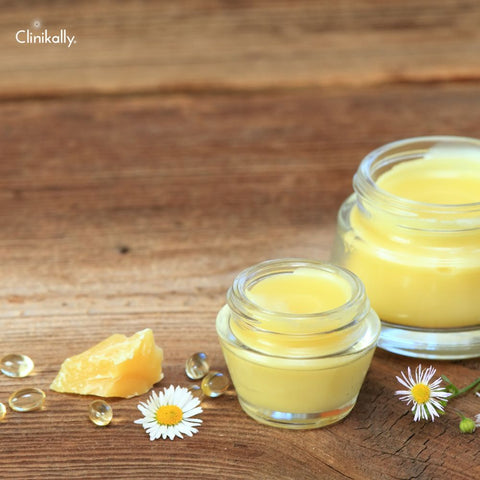
Homemade Cocoa Butter Lip Balm Recipe: Ingredients are 2 tablespoons cocoa butter, 2 tablespoons coconut oil, 1 tablespoon beeswax pellets. Optional: a few drops of essential oil (such as peppermint, vanilla, or lavender) for fragrance (make sure it's safe for use on lips). Measure out the cocoa butter, coconut oil, and beeswax pellets. In a double boiler or a heatproof bowl set over a pot of simmering water, melt the cocoa butter, coconut oil, and beeswax pellets together. Stir occasionally until fully melted and well combined. Be careful not to overheat the mixture. If desired, add a few drops of your chosen essential oil to the melted mixture and stir well to incorporate. This step adds fragrance to your lip balm. Once everything is melted and mixed, carefully pour the mixture into lip balm containers or small jars. Leave some space at the top to avoid spills. Allow the lip balm to cool and solidify at room temperature or in the refrigerator for faster results. This usually takes a couple of hours. Once the lip balm has solidified, you can label your containers with the date and ingredients used. Store them in a cool, dry place away from direct sunlight. Your homemade cocoa butter lip balm is now ready to use! Apply it to your lips whenever they need moisture and protection.
Comparing cocoa butter with other lip care ingredients
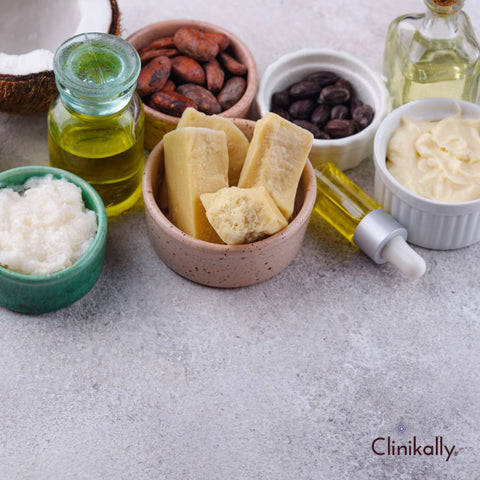
Let us compare cocoa butter to a few other popular lip care ingredients:
-
Shea Butter: Shea butter comes from the nuts of the shea tree, which is native to Africa. Shea butter, like cocoa butter, is high in fatty acids and vitamins, making it extremely moisturising and nourishing for the lips. It softens and smooths dry, chapped lips. Shea butter has a slightly different texture than cocoa butter, being creamier and softer at room temperature. Shea butter is commonly used in lip balms and lip care products, both alone and in combination with other ingredients.
-
Coconut Oil: Coconut oil comes from the kernels of coconuts. Coconut oil is extremely moisturising and contains fatty acids, which nourish and hydrate the lips. It also has antimicrobial properties, which can help prevent infections in the lips. Coconut oil is liquid at temperatures above 76°F (24°C) and solid at lower temperatures. It has a smooth and oily texture. Coconut oil is commonly used in making homemade lip balms and lip care products. It can be used alone or combined with other ingredients such as beeswax or shea butter.
-
Beeswax: Honeybees produce a natural wax known as beeswax. Beeswax forms a protective barrier on the lips, retaining moisture and preventing loss. It also helps lip balms and other lip care products keep their consistency and shape. Beeswax is solid at room temperature, but softens when applied to the skin. It provides structure and thickness to lip balms without feeling heavy or greasy. Beeswax is commonly used in lip balms, lipsticks, and other lip care products. It is frequently blended with oils and butter to create nourishing formulas.
Each of these ingredients has a distinct benefit for lip care, and they can be used alone or in combination to create effective lip care products that are tailored to individual preferences and needs.
Benefits of cocoa butter for anti-aging
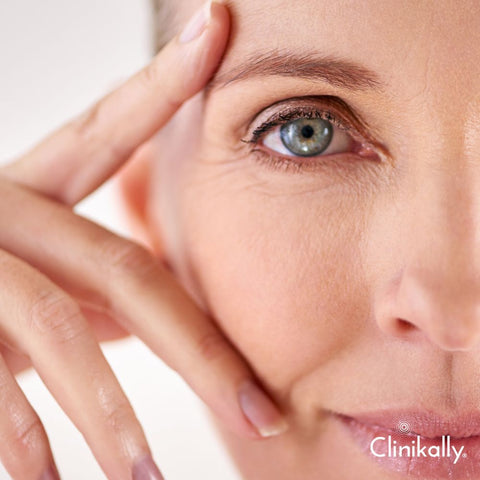
Cocoa butter, derived from the cocoa bean, is well-known for its excellent moisturising characteristics and is commonly used in beauty products. While scientific research on cocoa butter's anti-aging effects is limited, its composition and prospective benefits indicate that it may provide numerous benefits for ageing skin:
-
Reduces fine lines and wrinkles: The antioxidants in cocoa butter can help to protect the skin from free radicals and other forms of oxidative stress, which can contribute to premature ageing.
-
Promotes skin elasticity: Cocoa butter is also rich in vitamin E, which is known to help maintain skin elasticity, making it a great option for those looking to reduce the appearance of fine lines and wrinkles.
While cocoa butter has various possible benefits for ageing skin, it is important to remember that individual outcomes may vary. Furthermore, skincare products containing cocoa butter frequently include other helpful substances that enhance its effects. If you have specific skin concerns or disorders, conduct a patch test and check with a physician before using this skincare component.
Scientific evidence supporting cocoa butter for wrinkles

While there is anecdotal evidence and historical use of cocoa butter for a variety of skin concerns, including wrinkle reduction, scientific research on cocoa butter's efficacy for wrinkles has been limited. However, cocoa butter does contain several components that may contribute to its potential skin health benefits:
-
Antioxidants: Polyphenols and flavonoids found in cocoa butter can help combat oxidative stress and free radical damage. This may contribute to maintaining skin elasticity and preventing premature aging, including the formation of wrinkles.
-
Fatty acids: Cocoa butter contains a variety of fatty acids, including oleic acid, stearic acid, and palmitic acid. These fatty acids can help nourish and moisturize the skin, promoting hydration and improving the appearance of fine lines and wrinkles.
-
Emollient properties: Cocoa butter is emollient, which means it forms a protective barrier on the skin's surface that locks in moisture and prevents transepidermal water loss. This helps keep the skin hydrated, plump, and smooth, potentially reducing the appearance of wrinkles.
While cocoa butter may have moisturising and antioxidant properties for the skin, scientific research into its effects on wrinkles is limited. The majority of evidence supporting cocoa butter's skin health benefits stems from its moisturising properties and long-standing use in skincare products. It is important to note that individual reactions to skincare ingredients can vary, and what works for one person may not work for another. Furthermore, skincare results are frequently influenced by a variety of factors such as skin type, age, general health, and lifestyle habits.
If you are thinking about using cocoa butter or another skincare ingredient to reduce wrinkles, consult with a dermatologist or skincare professional for personalised advice and recommendations based on your specific needs.
DIY anti-aging cocoa butter formulas
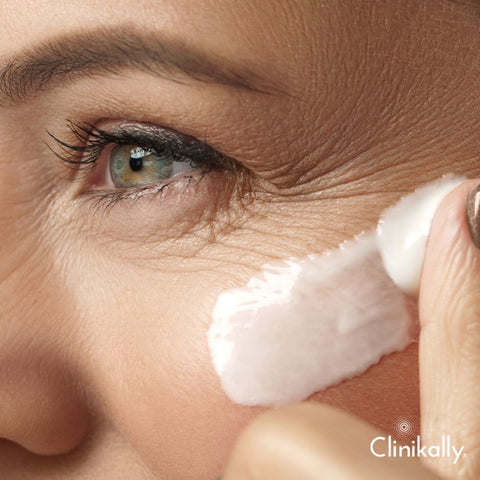
Creating your own DIY anti-aging cocoa butter formulas can be both fun and beneficial for your skin. Here are a few simple recipes to get you started:
-
Cocoa Butter and Vitamin E Cream: Ingredients are 3 tablespoons cocoa butter, 1 tablespoon coconut oil, and 1 teaspoon vitamin E oil. Optional: a few drops of essential oil (such as lavender or rosehip for added benefits and fragrance). In a double boiler or a heatproof bowl set over a pot of simmering water, melt the cocoa butter and coconut oil together. Once melted, remove from heat and allow the mixture to cool slightly. Stir in the vitamin E oil and essential oil (if using) until well combined. Transfer the mixture to a clean, airtight container and allow it to solidify at room temperature. Once solidified, your cocoa butter and vitamin E cream are ready to use. Apply it to your face and neck as a moisturizer, focusing on areas prone to wrinkles.
-
Cocoa Butter and Argan Oil Serum: Ingredients are 2 tablespoons cocoa butter, 1 tablespoon argan oil and 1 teaspoon rosehip oil. Optional: a few drops of frankincense essential oil for added anti-aging benefits. Melt the cocoa butter in a double boiler or a heatproof bowl set over a pot of simmering water. Once melted, remove from heat and stir in the argan oil, rosehip oil, and frankincense essential oil (if using). Allow the mixture to cool slightly before transferring it to a clean, airtight container. Let the serum solidify at room temperature before using. Apply a few drops of the serum to your face and neck, focusing on areas with fine lines and wrinkles, both morning and night.
-
Cocoa Butter and Green Tea Eye Cream: Ingredients are 2 tablespoons cocoa butter, 1 tablespoon sweet almond oil, 1 teaspoon beeswax pellets and 1 teaspoon brewed green tea (cooled). Optional: a few drops of chamomile essential oil for soothing properties. In a double boiler or a heatproof bowl set over a pot of simmering water, melt the cocoa butter, sweet almond oil, and beeswax pellets together. Once melted, remove from heat and stir in the brewed green tea and chamomile essential oil (if using). Allow the mixture to cool slightly before transferring it to a clean, airtight container. Let the eye cream solidify at room temperature before using. Apply a small amount of eye cream to the delicate skin around your eyes and gently tap until absorbed. Use it morning and night for best results.
These DIY cocoa butter formulas can nourish, hydrate, and protect your skin from free radicals, reducing the appearance of fine lines and wrinkles over time. Always perform a patch test before using any new skincare product, especially if you have sensitive skin or allergies. Enjoy your homemade skincare creations!
Combining cocoa butter with other anti-aging ingredients
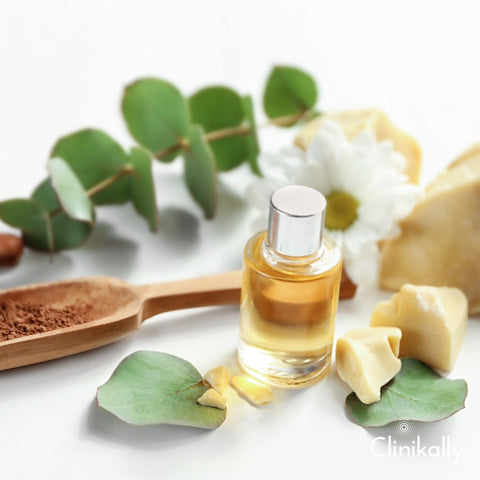
Combining cocoa butter with other anti-aging ingredients can result in effective skincare formulations that address multiple aspects of skin ageing. Here are a few effective combinations:
-
Cocoa Butter and Retinol: Retinol, a form of vitamin A, is well-known for its ability to increase cell turnover, stimulate collagen production, and reduce the appearance of fine lines and wrinkles. When combined with cocoa butter, which provides moisturization and antioxidant benefits, it can create a powerful anti-aging treatment. To incorporate retinol into your skincare routine, apply a retinol serum or cream in the evening and follow with a cocoa butter moisturiser to replenish moisture and soothe the skin.
-
Cocoa Butter and Hyaluronic Acid: Hyaluronic acid is a humectant that attracts and retains moisture in the skin, thereby plumping fine lines and wrinkles. Combining it with cocoa butter improves its hydrating properties, providing long-lasting moisture and increasing skin elasticity. Look for serums or moisturisers that include cocoa butter and hyaluronic acid. Apply the serum first to damp skin, then the cocoa butter moisturiser to seal in moisture.
-
Cocoa Butter and Vitamin C: Vitamin C is a potent antioxidant that neutralises free radicals, brightens the skin, and stimulates collagen production. When combined with cocoa butter, it can help fade dark spots, even out skin tone, and minimise the appearance of wrinkles. In the morning, apply a vitamin C serum to protect your skin from environmental damage. Follow with a cocoa butter moisturiser to nourish and hydrate the skin.
-
Cocoa Butter and Peptides: Peptides are short chains of amino acids that can help with skin firmness, elasticity, and texture. When combined with cocoa butter, they can enhance the skin's natural regeneration process, resulting in smoother, more youthful-looking skin. Look for anti-aging creams or serums that contain both peptides and cocoa butter. Apply the product to clean skin morning and night for best results.
-
Cocoa Butter and Niacinamide: Niacinamide, also known as vitamin B3, has multiple benefits for the skin, including improving skin texture, reducing the appearance of fine lines and wrinkles, and brightening dull complexion. Combining it with cocoa butter can provide comprehensive anti-aging care while keeping the skin moisturized. Incorporate a niacinamide serum or cream into your skincare routine. Follow up with a cocoa butter moisturizer to seal in the benefits and maintain skin hydration.
When combining cocoa butter with other anti-aging ingredients, choose products that are appropriate for your skin type and concerns. Before using new products, perform patch tests to ensure compatibility. If you have any specific skin conditions or sensitivities, consult with a dermatologist.
Benefits of cocoa powder for face

Cocoa powder, made from roasted and ground cocoa beans, is not only a delicious culinary ingredient, but it also has potential skincare benefits when applied topically to the face. Here are some of the potential benefits of using cocoa powder on your skin:
-
Exfoliates the skin: Cocoa powder can be used as a gentle exfoliant, helping to remove dead skin cells and unclog pores, leaving the skin feeling smooth and refreshed.
-
Reduces redness and inflammation: The antioxidants in cocoa powder can help to soothe and calm irritated skin, reducing redness and inflammation.
While cocoa powder has several potential skin benefits, it is important to use it in moderation and perform a patch test to rule out any negative reactions, especially if you have sensitive or allergy-prone skin. Furthermore, incorporating cocoa powder into homemade skincare recipes or purchasing skincare products with cocoa powder from reputable brands can help ensure safe and effective use.
Cocoa powder face mask recipes
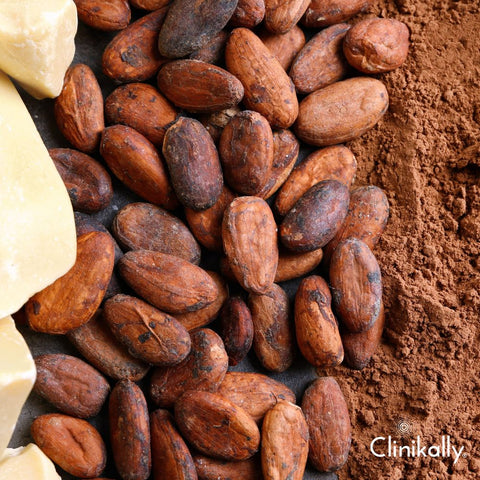
Cocoa powder is not only delicious, but it also has antioxidant properties that may benefit the skin. Here are a few cocoa powder face mask recipes that you can try at home:
-
Moisturizing Cocoa Powder Face Mask: Ingredients are 2 tablespoons cocoa powder, 1 tablespoon honey and 1 tablespoon plain yogurt. In a small bowl, mix the cocoa powder, honey, and yogurt until well combined. Apply the mixture to clean, dry skin, avoiding the delicate eye area. Leave the mask on for 15-20 minutes. Rinse off with warm water, then pat your skin dry. Follow up with your favorite moisturizer. This mask helps hydrate and nourish the skin, leaving it feeling soft and moisturized. Cocoa powder provides antioxidants, honey has antibacterial properties, and yogurt contains lactic acid, which helps exfoliate and brighten the skin.
-
Brightening Cocoa Powder Face Mask: Ingredients are 2 tablespoons cocoa powder, 1 tablespoon plain yogurt and 1 teaspoon lemon juice. Mix the cocoa powder, yogurt, and lemon juice in a bowl until smooth. Apply the mask to clean, dry skin, avoiding the eye area. Leave it on for 10-15 minutes. Rinse off with lukewarm water, then pat your skin dry. Follow up with a moisturizer and sunscreen if using during the day. This mask helps brighten the complexion and fade dark spots over time. Cocoa powder provides antioxidants, yogurt gently exfoliates, and lemon juice contains vitamin C, which helps even out skin tone and lighten hyperpigmentation.
-
Exfoliating Cocoa Powder Face Mask: Ingredients are 2 tablespoons cocoa powder, 1 tablespoon coffee grounds and 1 tablespoon coconut oil. Combine the cocoa powder, coffee grounds, and coconut oil in a bowl. Mix well until you get a thick paste. Gently massage the mixture onto damp skin using circular motions, focusing on areas prone to roughness or dullness. Leave the mask on for 10-15 minutes. Rinse off with warm water, then pat your skin dry. Follow up with a moisturizer. This mask not only exfoliates dead skin cells but also provides antioxidant benefits. Cocoa powder and coffee grounds help improve circulation and brighten the skin, while coconut oil moisturizes and nourishes.
Before using any new skincare product or ingredient, it is critical to conduct a patch test to ensure that you have no adverse reactions. If you have sensitive skin or allergies, you should consult a dermatologist before using these face masks. Enjoy pampering your skin with these cocoa powder goodies!
Benefits of antioxidants in cocoa for facial skin

The antioxidants found in cocoa offer several benefits for facial skin health:
-
Cocoa is rich in antioxidants such as flavonoids, polyphenols, and catechins. These antioxidants help neutralize free radicals, which are unstable molecules that can cause oxidative damage to skin cells. By neutralizing free radicals, antioxidants in cocoa protect the skin from premature aging, including fine lines, wrinkles, and age spots.
-
Exposure to ultraviolet (UV) radiation from the sun can lead to skin damage and accelerate skin aging. The antioxidants in cocoa have photoprotective properties, helping to protect the skin from UV-induced damage. While cocoa antioxidants cannot replace sunscreen, they can complement sun protection measures by providing additional defense against UV radiation.
-
Cocoa antioxidants can promote collagen production in the skin. Collagen is a protein that provides structural support and elasticity to the skin. By stimulating collagen synthesis, cocoa antioxidants can help improve skin texture, firmness, and elasticity, reducing the appearance of fine lines and wrinkles.
-
Antioxidants in cocoa help improve skin barrier function and moisture retention. This can help keep the skin hydrated and prevent transepidermal water loss (TEWL), which can lead to dryness, flakiness, and dullness.
-
Cocoa antioxidants have anti-inflammatory properties that can help soothe irritated or inflamed skin. They may help alleviate symptoms of inflammatory skin conditions such as acne, eczema, or psoriasis.
-
Regular use of cocoa antioxidants can help brighten the complexion and promote a more even skin tone. By reducing oxidative stress and promoting cell turnover, cocoa antioxidants can fade dark spots, hyperpigmentation, and other signs of skin discoloration.
Tips for using cocoa powder in skincare
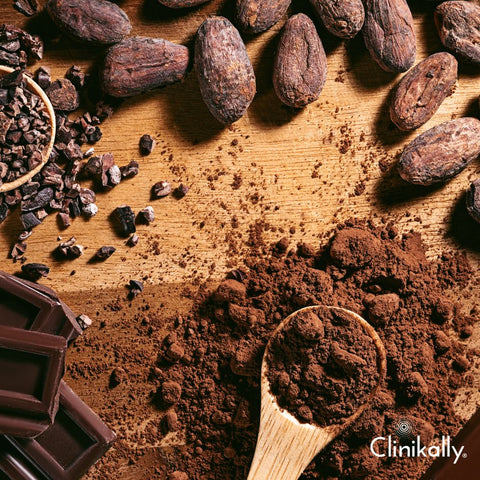
Cocoa powder's antioxidant-rich composition can provide a variety of skin benefits. Here are some suggestions for using cocoa powder in your skincare routine:
-
Choose Unsweetened Cocoa Powder: When choosing cocoa powder for skincare, look for unsweetened, pure cocoa powder with no added sugars or flavours. This ensures that you receive the most beneficial properties of cocoa without any unnecessary additives.
-
Patch Tests: Before applying cocoa powder to your entire face, conduct a patch test on a small area of skin to rule out any allergic reactions or sensitivities. This is especially important for people with sensitive skin or allergies.
-
Mix with Suitable Ingredients: Cocoa powder can be combined with a variety of other skincare ingredients to make masks, scrubs, or treatments tailored to your skin's specific needs. Honey (moisturising and antibacterial), yoghurt (exfoliating and soothing), and coconut oil (hydrating and nourishing) are popular ingredients to combine with cocoa powder.
-
Adjust Consistency: Depending on the skincare product you are making, you may need to change the consistency of the mixture. If you are making a thick mask or a gentle exfoliating scrub, adjust the amount of cocoa powder to achieve the desired texture.
-
Apply Evenly: When using cocoa powder-based skincare products on your face, make sure to distribute the mixture evenly for consistent coverage. Avoid the delicate eye area and any areas with broken or irritated skin.
-
Leave on for Recommended Time: Follow the directions for leaving the cocoa powder treatment on your skin. This may change depending on the recipe or product you are using. Masks can usually be left on for 10-20 minutes, whereas scrubs are massaged into the skin for a few minutes before being rinsed off.
-
Rinse Off Thoroughly: Once the recommended time has passed, thoroughly rinse the cocoa powder treatment with lukewarm water. Use a clean towel to gently pat dry your skin.
-
Moisturise After: After any cocoa powder skincare treatment, apply a suitable moisturiser to lock in hydration and keep your skin feeling soft and supple.
-
Be Consistent: Like any skincare ingredient, consistency is key to seeing results. Incorporate cocoa powder treatments into your skincare routine regularly to experience the full benefits over time.
By following these tips, you can effectively incorporate the cocoa powder into your skincare routine to promote healthier, more radiant-looking skin.
Benefits of cocoa butter body oil

Cocoa butter body oil, derived from cocoa beans, provides numerous skin benefits due to its rich emollient properties and high antioxidant content. Here are some of the advantages of using cocoa butter body oil:
-
Moisturizes and softens skin: Cocoa butter body oil is a great option for those looking to hydrate and soften the skin, especially during the winter months.
-
Reduces the appearance of scars: Cocoa butter body oil is also believed to help reduce the appearance of scars and other forms of skin damage.
Best practices for applying cocoa butter body oil

Using cocoa butter body oil can provide a luxurious and nourishing experience for your skin. Here are some best practices for using cocoa butter body oil effectively:
-
Look for a high-quality cocoa butter body oil that contains both pure cocoa butter and other nourishing ingredients. Avoid products with additives, artificial fragrances, or potentially irritating ingredients.
-
Start with clean, dry skin. Take a warm shower or bath to cleanse your skin and open up your pores, which will help the oil absorb more effectively. Gently pat your skin dry with a towel before applying the body oil.
-
Cocoa butter body oil is rich and concentrated, so you only need a small amount to cover a large area of skin. Dispense a few drops of oil into the palm of your hand.
-
Rub your hands together to warm the cocoa butter body oil slightly. This will help it spread more easily and enhance its absorption into the skin.
-
For maximum hydration, apply the cocoa butter body oil to slightly damp skin. This helps lock in moisture and allows the oil to penetrate deeply into the skin.
-
Using gentle, circular motions, massage the cocoa butter body oil into your skin. Focus on areas that are prone to dryness, such as elbows, knees, and heels. Take your time and enjoy the soothing sensation of the oil on your skin.
-
After applying the cocoa butter body oil, allow it some time to absorb fully into your skin before getting dressed. This will help prevent any transfer of oil onto your clothes and ensure that your skin receives maximum hydration.
-
Depending on your skin's needs, you may choose to reapply cocoa butter body oil throughout the day. Pay attention to how your skin feels and looks, and apply more oil as needed to keep it moisturized and supple.
-
Store your cocoa butter body oil in a cool, dry place away from direct sunlight to maintain its freshness and efficacy. Be sure to close the bottle tightly after each use to prevent oxidation and preserve the oil's quality.
The role of cocoa butter oil in hydrating dry skin
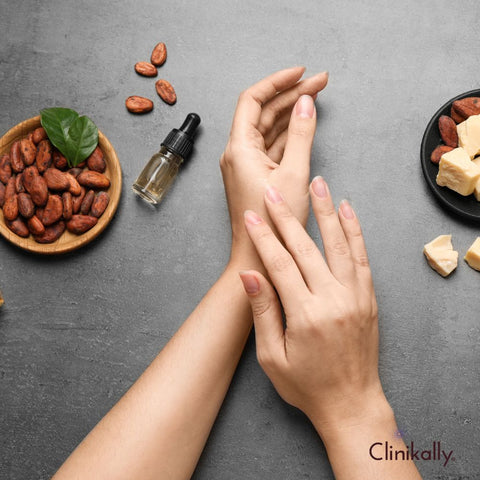
Cocoa butter oil's high fatty acid, antioxidant, and emollient content helps to hydrate dry skin. Here's how cocoa butter oil moisturises dry skin:
-
Emollient Properties: Cocoa butter oil is extremely emollient, which means it forms a protective barrier on the skin's surface that helps to retain moisture. This barrier helps to prevent water loss from the skin, allowing it to stay hydrated for longer.
-
Fatty Acids: Cocoa butter oil contains a variety of fatty acids, including oleic acid, stearic acid, and palmitic acid. These fatty acids help to replenish the skin's lipid barrier, which is necessary for hydration and moisture retention.
-
Deep Moisturization: Cocoa butter oil can penetrate deeply into the skin, delivering intense moisture to dry and dehydrated skin cells. This helps to nourish the skin from within, leaving it feeling soft, smooth, and supple.
-
Antioxidant Properties: Cocoa butter oil contains antioxidants like polyphenols and flavonoids, which help to neutralise free radicals and protect the skin against oxidative stress. This can help to protect the skin's barrier and keep it healthy and hydrated.
-
Soothing and Healing: Cocoa butter oil has soothing and healing properties that can help to relieve irritated or inflamed skin. It is especially beneficial for conditions like eczema, dermatitis, and psoriasis, which are characterised by dryness and inflammation.
-
Improved Skin Elasticity: Regular use of cocoa butter oil can help to improve skin elasticity, making it more resistant to environmental stressors and less prone to dryness and dehydration.
-
Natural Fragrance: Cocoa butter oil has a rich, chocolatey aroma that can provide a sensory indulgence during skincare routines, enhancing the overall experience of hydrating dry skin.
Blending cocoa butter oil with essential oils
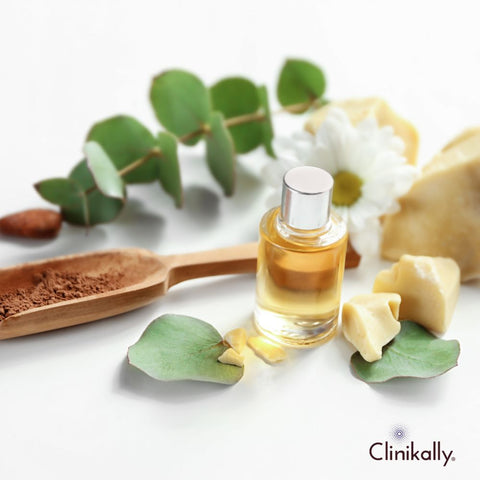
Combining cocoa butter oil with essential oils can result in a luxurious and personalised skincare product tailored to your specific needs and preferences. Here's how to effectively blend cocoa butter oil and essential oils:
-
Choose High-Quality Ingredients: Use high-quality cocoa butter oil and pure essential oils for the best results. Ensure that the essential oils you select are suitable for topical use and safe for your skin type.
-
Determine Your Skin Goals: Think about your skincare goals and the benefits you hope to achieve with the blended oil. Choose essential oils that are appropriate for your goals, whether you want to relax, rejuvenate, hydrate, or address specific skin concerns.
-
Choose Complementary Essential Oils: Use essential oils that complement the properties of cocoa butter oil and provide additional skin benefits. Examples include lavender essential oil, rosehip essential oil, frankincense essential oil, and chamomile essential oil.
-
Dilution Ratio: To avoid skin irritation, essential oils should be diluted properly before application. A general guideline for diluting essential oils in carrier oils such as cocoa butter oil is 1-2% for facial use and 2-5% for body application. For example, if you are making a 1 oz (30 ml) blend, you would use 6-12 drops of essential oil for facial use and 12-30 drops for body use.
-
Blend the Oils: In a clean, dry container, combine the desired amount of cocoa butter oil and the essential oils. Using a dropper or pipette, add the essential oils drop by drop, mixing thoroughly between each addition. Take note of the total number of drops to ensure accurate dilution.
-
Patch Test Sensitivity: Apply a small amount of the blended oil to a small area of skin and look for any negative reactions, such as redness, irritation, or itching. If irritation develops, discontinue use and rinse the area with water.
-
Storage and Usage: To maintain the potency of the blended oil, store it in a dark-colored glass bottle out of direct sunlight in a cool, dry place. Follow the suggested dilution guidelines for safe and efficient use when using the blended oil for massage, moisturising, or aromatherapy, as desired.
By combining cocoa butter oil with carefully chosen essential oils, you can create a personalised skincare product that addresses your specific skin needs while also indulging your senses with aromatic properties.
Final Thoughts: Integrating Cocoa Butter into Your Skincare Regimen

Integrating cocoa butter into your skincare routine can nourish, protect, and rejuvenate your skin, leaving it looking and feeling great. Whether you use cocoa butter-based products or make your DIY formulations, incorporating this natural ingredient into your skincare routine can be a satisfying and effective way to care for your skin.
















